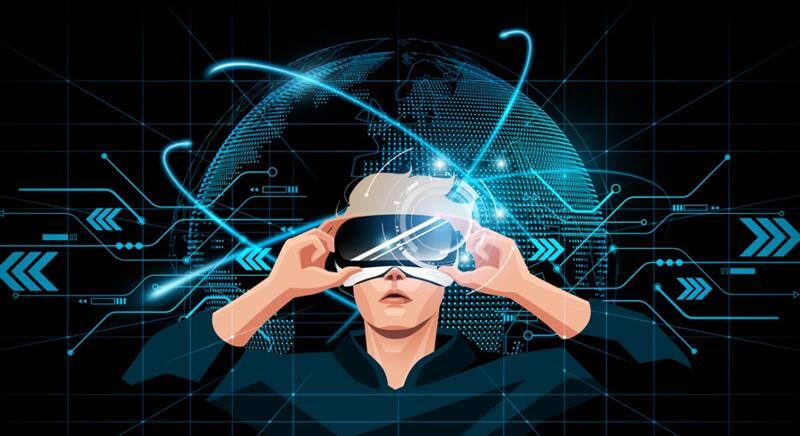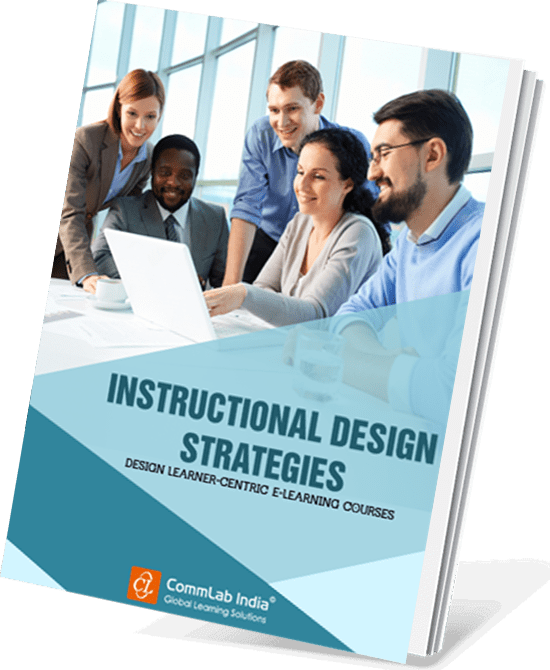5 Immersive Strategies to Make Custom eLearning Personal and Experiential

The digital age has ushered in an era of unprecedented access to information. Yet, the sheer volume of available content can be overwhelming, making it difficult to truly engage with and retain knowledge. This is where the power of immersive learning comes in. This shift towards personalized, experiential learning is driving a revolution in the eLearning landscape. Immersive strategies are at the forefront of this revolution, offering a powerful way to captivate learners and foster deeper understanding. This blog post will dive into the various immersive strategies that can be used to create personalized and experiential custom eLearning journeys that are both effective and engaging.
→ Download eBook Now: Instructional Design Strategies
Table of Contents
- Why Does Immersive Learning Matter?
- How to Lay the Foundation for Immersive Learning?
- What are the Best Immersive Strategies?
- How to Build a Culture of Learning Beyond the Course?
- How to Measure the Impact of Immersive Learning?
- What is The Future of Immersive Learning?
Why Does Immersive Learning Matter?
Gone are the days of passive learning, where individuals simply absorb information presented to them. Today, learners crave interactive, engaging experiences that cater to their individual needs and preferences. Immersive learning strategies are at the forefront of this revolution, offering a powerful way to captivate learners and foster deeper understanding. By leveraging technology and innovative instructional design, we can create eLearning experiences that are not only informative but also engaging, memorable, and impactful. In a world where knowledge is constantly evolving, the ability to learn effectively is more critical than ever. Immersive strategies offer a number of key benefits:
- Increased engagement: By creating interactive and stimulating learning environments, we can capture learners' attention and motivate them to actively participate in the learning process.
- Improved retention: Experiential learning, through scenarios, simulations, and gamification, allows learners to apply knowledge in a practical context, leading to better retention and recall.
- Enhanced application: Immersive learning bridges the gap between theory and practice, enabling learners to develop real-world skills and apply them confidently in their professional lives.
- Personalized learning journeys: By tailoring the learning experience to individual needs and preferences, we can empower learners to take ownership of their development and achieve their full potential.
Want to Make Custom eLearning Experiential? Try Immersive Strategies!
Here are a few ones to get started
- Scenarios and Storytelling
- Gamification and Interactive Challenges
- Guided Learning with Avatars and Virtual Coaches
- Simulations and Virtual Reality
- Social Learning and Collaboration
How to Lay the Foundation for Immersive Learning?
Before diving into the exciting world of immersive strategies, it's crucial to establish a solid foundation. Just like a house needs a strong base, effective eLearning requires careful planning and a deep understanding of the learners and their needs. This section will guide you through the essential steps to prepare for creating truly immersive and personalized learning experiences.
1. Know Your Audience: The Cornerstone of Effective eLearning
Imagine trying to build a car without knowing who will be driving it. You wouldn't know whether to prioritize speed, safety, or fuel efficiency. Similarly, understanding your learners is paramount to designing effective eLearning. This involves:
- Identifying your target audience: Who are your learners? What are their demographics (age, profession, education level)? What are their learning styles and preferences? What prior knowledge do they possess?
- Conducting needs assessments: What specific skills or knowledge do your learners need to acquire? What are their learning goals and objectives? What challenges do they face in their learning journey?
- Performing a gap analysis: What is the difference between their current knowledge and the desired level of competency? This analysis helps you identify the specific areas where your eLearning needs to focus.
By thoroughly understanding your learners, you can tailor the learning experience to their specific needs and preferences, making it more relevant, engaging, and effective.
2. Learner-Centric Design: Putting the Learner First
In the past, eLearning often followed a one-size-fits-all approach. However, modern learners demand personalized experiences that cater to their individual needs and preferences. This is where learner-centric design comes in. It involves:
- Applying User Experience (UX) principles: Ensure your eLearning is intuitive, easy to navigate, and visually appealing. Consider the user interface, layout, and overall flow of the learning experience.
- Designing intuitive navigation: Learners should be able to easily find the information they need and move through the course without confusion. Use clear headings, menus, and progress indicators.
- Ensuring accessibility: Make your eLearning accessible to all learners, including those with disabilities. Provide alternative formats for content, such as closed captions, transcripts, and screen reader compatibility.
By putting the learner at the center of the design process, you can create custom eLearning experiences that are engaging, effective, and accessible to all.
3. Harnessing Technology for Immersion
Technology plays a crucial role in creating immersive learning experiences. It's essential to choose the right tools and platforms to achieve your learning objectives. This involves:
- Exploring eLearning platforms and tools: Research different Learning Management Systems (LMS), authoring tools, and other technologies that can support your immersive strategies.
- Selecting the right technology: Consider your budget, technical expertise, type of authoring tool, and the specific needs of your learners when choosing technology.
- Integrating mobile learning and microlearning: Make your eLearning accessible on mobile devices and break down content into bite-sized modules for convenient learning.

Instructional Design Strategies to Design Engaging eLearning Courses
Design Learner-Centric eLearning
- Importance of ID Strategies in eLearning
- Parameters to Select the Right ID Strategy
- ID Strategies for Effective Results
- Case Studies
What are the Best Immersive Strategies?
Now that we have the foundation in place, let's dive into the heart of immersive learning: the strategies that bring these experiences to life. This section will explore some of the most powerful and effective ways to engage learners and create personalized learning journeys.
1. Scenarios and Storytelling: Creating Immersive Narratives
One of the most effective ways to immerse learners is to create realistic and engaging scenarios. By placing learners in a simulated environment, we can help them apply their knowledge and skills in a meaningful context. Storytelling is a powerful tool for creating compelling scenarios. By weaving together characters, plots, and challenges, we can capture learners' attention and motivate them to learn more.
Example: Using Scenarios to Train Customer Service Representatives
Imagine a customer service training program that uses a series of realistic scenarios to teach customer service skills. Learners are presented with different customer scenarios, each with its own unique challenges and communication styles. They are then asked to role-play as the customer service representative and respond appropriately. This type of hands-on experience allows learners to practice their skills in a safe and controlled environment, receiving feedback and guidance along the way.
2. Gamification and Interactive Challenges: Making Learning Fun and Engaging
Gamification is the process of adding game-like elements to a learning experience. This can include things like points, badges, leaderboards, and challenges. By gamifying learning, we can make it more fun and engaging, motivating learners to achieve their goals.

Example: Gamifying Compliance Training for Healthcare Professionals
To make compliance training more engaging, a healthcare organization implemented a gamification strategy. Learners were assigned to virtual teams and competed against each other to complete a series of challenges. Each challenge involved completing a specific compliance module and answering a series of questions correctly. Points were awarded for completing challenges and answering questions correctly, and learners could move up the leaderboard based on their performance. This gamified approach made compliance training more fun and engaging, resulting in higher levels of learner satisfaction and retention.
3. Guided Learning with Avatars and Virtual Coaches: Providing Personalized Support
Avatars and virtual coaches can be used to provide personalized guidance and support to learners. These digital characters can interact with learners, answer their questions, and provide feedback on their progress. This type of guided learning can be particularly helpful for learners who are new to the subject matter or who need additional support.
Example: Implementing Avatar-Guided Learning for Onboarding New Employees
A large corporation implemented an avatar-guided learning program to onboard new employees. The program featured a virtual assistant named "Alex," who guided learners through a series of modules covering the company's culture, policies, and procedures. Alex provided personalized feedback and support, answering learners' questions and helping them to navigate the learning process. This avatar-guided approach resulted in a more engaging and effective onboarding experience for new employees.
4. Simulations and Virtual Reality: Creating Immersive Learning Environments
Simulations and virtual reality (VR) can be used to create immersive learning experiences that are virtually indistinguishable from real life. By placing learners in simulated environments, we can help them develop the skills and knowledge they need to succeed in real-world situations.
Example: Training Surgeons with VR Simulations
Medical schools are using VR simulations to train surgeons in a safe and controlled environment. Surgeons can practice complex procedures on virtual patients, receiving feedback on their performance and identifying areas for improvement. This type of immersive training can help surgeons to develop the skills and confidence they need to perform complex surgeries safely and effectively.
5. Social Learning and Collaboration: Fostering a Community of Learners
Collaborative learning and social interaction are effective means of improving learning. By encouraging learners to engage with one another and exchange insights, we can cultivate a supportive community atmosphere.
Example: Fostering Collaboration in a Virtual Classroom Environment
An instructor created a virtual classroom environment where employees could collaborate on group projects, participate in online discussions, and share their work with each other. This social learning approach helped them to develop critical thinking skills, problem-solving abilities, and teamwork skills. Here are a few collaborations you can use -

How to Build a Culture of Learning Beyond the Course?
While immersive strategies play a crucial role in creating engaging eLearning experiences, they are most effective when implemented within a supportive learning culture. This section explores how to foster a culture that values continuous learning and development.
1. Leadership Buy-in and Support
A thriving learning culture starts at the top. Leaders who champion learning and development set the tone for the entire organization. This involves:
- Communicating the importance of learning: Leaders need to clearly articulate the value of learning and development to the organization's success. This can be done through regular communication, highlighting success stories, and recognizing employees who actively engage in learning.
- Providing resources and opportunities: Invest in learning resources, tools, and technologies that support employee development. Offer opportunities for employees to attend conferences, workshops, and training programs.
- Leading by example: Leaders who actively participate in learning and development demonstrate their commitment to continuous improvement and inspire others to do the same.
2. Peer-to-Peer Learning and Mentorship
Learning is often more effective when it happens in a social context. Encourage peer-to-peer learning and mentorship programs to foster a collaborative learning environment. This can involve:
- Creating communities of practice: Establish online or in-person communities where employees can share knowledge, ask questions, and learn from each other.
- Implementing mentorship programs: Pair experienced employees with newer employees to provide guidance, support, and knowledge transfer.
- Encouraging knowledge sharing: Create a culture where employees are encouraged to share their expertise and learn from each other.
3. Continuous Feedback and Recognition
Feedback and recognition are essential components of a learning culture. Provide regular feedback to employees on their learning progress and recognize their achievements. This can involve:
- Providing constructive feedback: Offer specific and actionable feedback that helps employees identify areas for improvement and grow their skills.
- Recognizing learning achievements: Celebrate employee successes and milestones in their learning journey. This can be done through public acknowledgements, awards, or other forms of recognition.
- Creating a culture of continuous feedback: Encourage employees to seek feedback from their peers, managers, and mentors. Foster a culture where feedback is seen as a valuable tool for growth and development.
- By fostering an environment that empowers employees to achieve their full potential by promoting a culture that prioritizes learning, offers growth opportunities, and acknowledges accomplishments. This approach ultimately leads to higher engagement, productivity, and innovation.
How to Measure the Impact of Immersive Learning?
Creating engaging and immersive eLearning experiences is only half the battle. To truly understand the effectiveness of your efforts, you need to measure their impact. This section will explore how to evaluate learning outcomes, demonstrate return on investment (ROI), and use data to continuously improve your eLearning initiatives.
1. Evaluating Learning Outcomes: Does it Actually Work?
It's essential to go beyond simply delivering content and assess whether learners have actually acquired the knowledge and skills you intended to impart. This involves:
- Using assessments to measure knowledge and skills acquisition: Implement various assessment methods like gamified assessments, quizzes, game-based tests, simulations, and projects to gauge learners' understanding and ability to apply what they've learned.
- Tracking learner progress and engagement: Monitor learners' progress throughout the course, track completion rates, time spent on modules, and participation in discussions to identify areas of strength and weakness.
- Gathering feedback through surveys and interviews: Collect qualitative data to gain insights into learners' perceptions of the course, its effectiveness, and areas for improvement.
By employing a combination of quantitative and qualitative evaluation methods, you can gain a comprehensive understanding of the impact of your immersive learning program.
2. Demonstrating ROI: The Value Proposition of eLearning
While the benefits of immersive learning are numerous, it's crucial to demonstrate its value to stakeholders in concrete terms. This means showcasing how it contributes to organizational goals and delivers a positive ROI. This can be achieved by:
- Analyzing the impact of immersive learning on business goals: Connect learning outcomes to tangible business results. For example, demonstrate how a sales training program led to increased sales or how a customer service course improved customer satisfaction scores.
- Measuring cost savings and productivity gains: Calculate the cost savings associated with eLearning compared to traditional training methods. Analyze how improved employee performance and reduced errors contribute to productivity gains.
- Communicating the value of eLearning to stakeholders: Present your findings in a clear and concise manner, highlighting the positive impact of immersive learning on employee performance, business outcomes, and organizational growth.
By demonstrating the tangible benefits of your eLearning program, you can secure continued support and investment in its development and improvement.
3. Continuous Improvement: The Journey to eLearning Excellence
Effective eLearning is an iterative process. To ensure your programs remain relevant and impactful, it's essential to continuously evaluate and refine them based on data and feedback. This involves:
- Using data and analytics to optimize eLearning design: Analyze learner data to identify areas where the course can be improved. For example, if many learners struggle with a particular module, you may need to revise the content or provide additional support.
- Gathering learner feedback to refine and improve courses: Actively solicit feedback from learners throughout the learning process and use this feedback to make adjustments and improvements.
- Staying updated on emerging trends and technologies: The eLearning landscape is constantly evolving. Stay informed about new technologies, instructional design principles, and best practices to ensure your programs remain cutting-edge.
What is The Future of Immersive Learning?
The world of eLearning is constantly evolving, with new technologies and approaches emerging all the time. This section explores some of the most exciting trends shaping the future of immersive learning and how they can further personalize and enhance the learning experience.
1. Artificial Intelligence (AI) and Personalized Learning: Tailoring the Journey
AI is poised to revolutionize the way we learn, offering unprecedented opportunities for personalization and adaptation. This includes:
- Adaptive learning platforms: These platforms use AI algorithms to analyze learner performance and adjust the learning path accordingly. This ensures that learners are always challenged at the appropriate level and receive the support they need to succeed.
- AI-powered tutors and mentors: Imagine having a virtual tutor who can provide personalized guidance, feedback, and support 24/7. AI-powered tutors can analyze learner data to identify areas of weakness and provide targeted instruction.
- Predictive analytics: AI can be used to predict learner behavior and identify potential roadblocks. This allows instructors to intervene proactively and provide support before learners become disengaged or fall behind.
By leveraging the power of AI, we can create truly personalized learning experiences that cater to the unique needs and preferences of each individual.
2. Extended Reality (XR) and Metaverse Learning: Stepping into New Worlds
Extended Reality (XR), which encompasses Virtual Reality (VR), Augmented Reality (AR), and Mixed Reality (MR), is opening up exciting new possibilities for immersive learning. This includes:
- Creating immersive learning experiences in virtual worlds: Imagine learning history by virtually walking through ancient Rome or exploring the human body by taking a VR tour of its internal organs. XR can transport learners to any place or time, creating truly immersive and unforgettable learning experiences.
- Using XR for simulations, training, and collaboration: XR technology can develop immersive simulations for training across multiple sectors, including healthcare, aviation, and manufacturing. This allows learners to hone their skills in a secure and regulated setting while receiving valuable feedback and support throughout the process.
- Exploring the potential of the metaverse for learning: The metaverse is a continuous, shared virtual space that allows users to engage with one another and digital entities. This creates thrilling opportunities for developing collaborative learning settings, virtual excursions, and immersive experiences.
XR and the metaverse have the potential to transform the way we learn, creating engaging and interactive experiences that were previously unimaginable.
3. The Role of Emotional Design and Neuroscience: Engaging the Whole Learner
To create truly impactful learning experiences, we need to consider not only the cognitive aspects of learning but also the emotional and neurological factors that influence how we learn and retain information. This includes:
- Designing eLearning that evokes emotions and enhances memory: By incorporating elements of storytelling, gamification, and visual design, we can create eLearning experiences that are not only informative but also emotionally engaging. Positive emotions, such as curiosity, excitement, and joy, can enhance memory and motivation.
- Applying principles of neuroscience to optimize learning: Neuroscience research can provide valuable insights into how the brain learns and processes information. By applying these principles to eLearning design, we can create experiences that are more effective and engaging.
- Creating engaging and memorable learning experiences: The goal of immersive learning is not just to impart knowledge but to create experiences that are memorable and impactful. By engaging the whole learner, we can create learning journeys that are both effective and enjoyable.
Parting Thoughts!
The journey through the realm of immersive learning has revealed a powerful truth: the future of learning is personalized, engaging, and experiential. By moving beyond traditional passive methods and embracing innovative strategies, we can unlock the full potential of learners and empower them to thrive in a rapidly changing world. Here’s a free eBook to help you understand more about various instructional design strategies that can shape your custom eLearning courses as per your learners’ needs.






